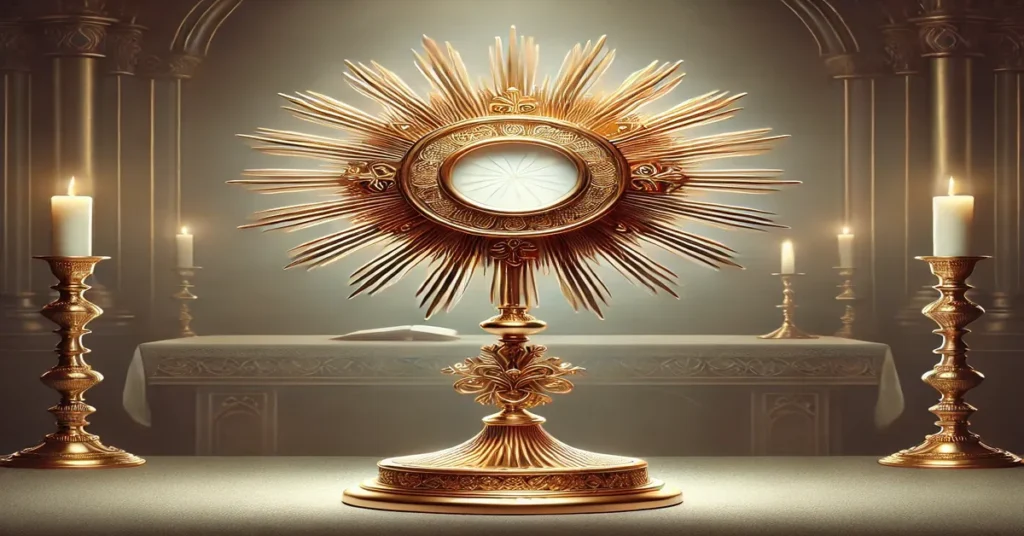The ostensorium, commonly known as the monstrance, is a sacred vessel in Christian liturgy, particularly within the Catholic Church. This ornately designed item is used to display the consecrated Eucharist, often during the rite of Eucharistic Adoration or Benediction. Through its elaborate design and powerful symbolism, the monstrance serves as a visual representation of the divine presence and a focal point for worshippers during religious ceremonies.
In this article, we will explore the history of the monstrance, its evolution, and its unique role in the Catholic tradition. We will examine its design, construction, and the profound spiritual significance it holds for millions of worshippers worldwide.
Table of Contents
- Introduction to the Monstrance (Ostensorium)
- Historical Development of the Monstrance
- The Role of the Monstrance in Catholic Tradition
- Symbolism and Spiritual Meaning
- Design and Components of the Monstrance
- Different Types of Monstrances
- The Process of Eucharistic Adoration and Benediction
- Care and Preservation of the Monstrance
- Conclusion
- FAQs
1. Introduction to the Monstrance (Ostensorium)
The ostensorium, or monstrance, derives its name from the Latin word monstrare, which means “to show” or “to display.” In Catholic tradition, the monstrance is used to present the consecrated host, believed to be the body of Christ, for public veneration and adoration. As an object of devotion, the monstrance serves as a medium through which believers connect with the divine presence, symbolized by the Eucharist.
Often crafted from precious metals and adorned with intricate designs, the monstrance is more than a vessel—it is an emblem of faith, reverence, and worship, inviting believers to contemplate the mysteries of the Eucharist.
2. Historical Development of the Monstrance
The use of monstrances can be traced back to the Middle Ages, when devotion to the Eucharist began to take a central role in Catholic worship. During the 13th century, the Feast of Corpus Christi was established to honor the presence of Christ in the Eucharist, and the monstrance was developed as a way to visually present the consecrated host.
The design of the monstrance evolved over centuries, becoming more ornate and symbolic. In earlier centuries, simpler reliquaries were used to hold relics, but as devotion to the Eucharist grew, more elaborate designs emerged to honor the host. By the Renaissance, monstrances became taller and more elaborate, adorned with jewels, gold, and religious symbols.
3. The Role of the Monstrance in Catholic Tradition
In Catholic worship, the monstrance plays a central role in Eucharistic Adoration, a devotional practice where the faithful gather to pray and reflect in the presence of the consecrated host. This practice signifies believers’ reverence for the real presence of Christ in the Eucharist.
Eucharistic Adoration
Eucharistic Adoration is a time for quiet prayer, meditation, and worship before the exposed Eucharist. Believers approach the monstrance with deep reverence, often kneeling in silent reflection, adoring the body of Christ in the host. This practice is seen as a way to cultivate a personal relationship with Christ and seek spiritual guidance.
Benediction of the Blessed Sacrament
Benediction is a ritual blessing with the Eucharist. The monstrance is placed on the altar, where the priest blesses the congregation with the host. This blessing is a moment of profound grace and divine connection, symbolizing Christ’s love and blessing upon the faithful.
4. Symbolism and Spiritual Meaning
The monstrance is rich in symbolism, with each element representing aspects of faith, divinity, and the heavenly realm. Key symbolic elements include:
- The Sunburst Design: The radiating rays around the central glass container often represent the light of Christ shining upon the world, symbolizing Jesus as the “Light of the World.”
- The Host: The consecrated host itself is the focal point, symbolizing the body of Christ and his presence among believers.
- Angels and Saints: Some monstrances feature figures of angels or saints, representing the heavenly witnesses to the Eucharist and the communion of saints.
- The Cross: Many monstrances incorporate a cross, emphasizing Christ’s sacrifice and resurrection.
Through these elements, the monstrance embodies both the mystery and beauty of faith, guiding worshippers towards spiritual contemplation.
5. Design and Components of the Monstrance
Monstrances are crafted with careful attention to detail, often from precious metals like gold and silver. Key components of a monstrance include:
a. Base and Stem
- The base provides stability, often decorated with symbols or scenes from Christ’s life. The stem elevates the host, making it visible to the congregation.
b. Throne or Luna Holder
- The throne, also known as the luna holder, is a glass or crystal compartment that holds the consecrated host. It is the central part of the monstrance.
c. Sunburst Rays
- Surrounding the luna holder, these rays symbolize divine light emanating from the host. They are often made to resemble sunbeams.
d. Cross or Religious Symbols
- Many monstrances include a cross or other religious symbols at the top, adding to their spiritual and symbolic depth.
6. Different Types of Monstrances
While the design of monstrances has evolved, several distinct styles exist today, including:
- Sunburst Monstrance: The most common style, featuring radiating rays around the host.
- Reliquary Monstrance: Often contains relics as well as the host, blending the veneration of relics and the Eucharist.
- Gothic Monstrance: Characterized by elaborate, intricate designs typical of Gothic architecture.
- Contemporary Monstrance: Modern designs may be simpler, focusing on minimalistic or abstract elements.
Each type of monstrance serves the same purpose but reflects different artistic and architectural styles.
7. The Process of Eucharistic Adoration and Benediction
Eucharistic Adoration
The process begins with the exposition of the Blessed Sacrament, where the priest places the consecrated host within the monstrance on the altar. Worshippers are invited to spend time in adoration, either silently or through prayer and hymns.
Benediction
In the rite of Benediction, the priest or deacon blesses the congregation with the monstrance, lifting it and tracing the sign of the cross. This moment is deeply significant, as believers receive Christ’s blessing through the host.
8. Care and Preservation of the Monstrance
Because monstrances are typically made from precious metals and adorned with delicate details, they require special care to maintain their beauty. Here are some steps taken to preserve them:
- Polishing: Regular cleaning with non-abrasive polish preserves the metal’s luster.
- Storage: Monstrances are stored in specially designed cases to prevent tarnishing or physical damage.
- Handling with Care: Only designated clergy or custodians typically handle the monstrance to ensure it remains in pristine condition.
Preserving the monstrance reflects respect for its sacred purpose and significance.
Conclusion
The monstrance, or ostensorium, is a revered symbol of the Catholic faith, representing the divine presence of Christ in the Eucharist. Its rich history, intricate design, and symbolic meaning make it one of the most profound objects in Christian worship. Through Eucharistic Adoration and Benediction, the monstrance serves as a bridge between the physical and spiritual, inviting believers to experience the presence of Christ in a powerful way.
Whether viewed as a historical artifact, a work of art, or a sacred vessel, the monstrance embodies the beauty, reverence, and mystery of faith. For believers, it is more than just an object; it is a profound representation of divine love and grace.
FAQs
1. What is the purpose of a monstrance?
A monstrance is used to display the consecrated host for adoration, allowing believers to venerate the body of Christ.
2. Why is the monstrance called an ostensorium?
“Ostensorium” comes from Latin, meaning “to show,” highlighting its purpose of displaying the Eucharist.
3. What materials are used to make a monstrance?
Monstrances are typically crafted from precious metals like gold or silver and may include jewels or enamel for decoration.
4. Why is the monstrance designed with rays around the host?
The rays symbolize the divine light of Christ, representing Jesus as the “Light of the World.”
5. What happens during Eucharistic Adoration?
During Adoration, the monstrance holding the Eucharist is placed on the altar, and believers spend time in prayer and worship.
6. How should a monstrance be cared for?
Monstrances should be polished regularly, stored in protective cases, and handled only by authorized clergy or custodians.







